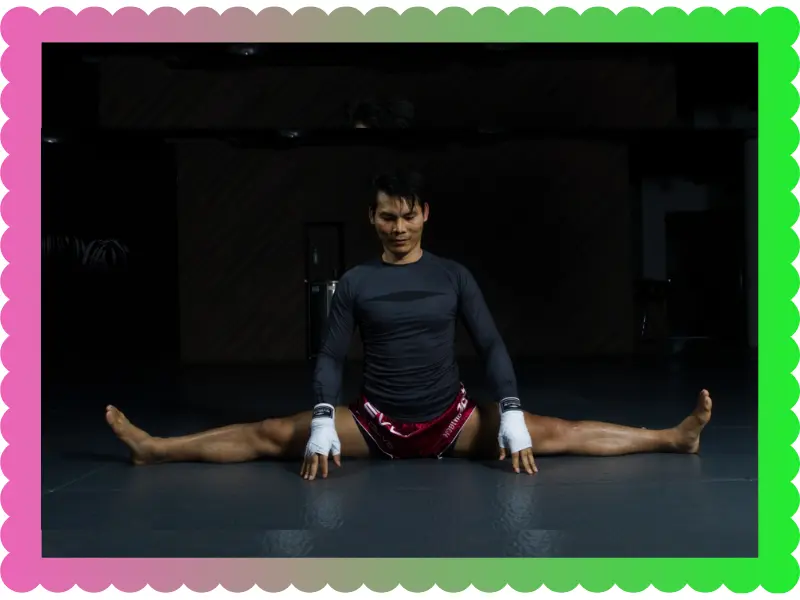
High kicks are the heart of Taekwondo. I’ve seen countless students in Phoenix walk into their first class, excited to throw those impressive head-height kicks. But here’s the truth: without proper stretching for taekwondo, those kicks just won’t happen.
Let me share what I’ve learned over the years of training and teaching at Taekwondoking. Flexibility isn’t magic. It’s a skill you build, just like any other technique.
Why Stretching Matters for High Kicks
Your body needs to be ready. Think of your muscles like rubber bands. Cold rubber bands snap. Warm, flexible ones stretch smoothly.
High kicks in Taekwondo demand more than just leg strength. You need:
- Hip flexibility to lift your leg
- Hamstring length to extend upward
- Core stability to maintain balance
- Lower back mobility for proper form
Without these elements, your kicks stay low. Even worse, you risk injury.
I remember my first month at Taekwondoking. My roundhouse kicks barely reached chest level. Frustrated doesn’t even begin to describe how I felt. But I stuck with a daily stretching routine. Six months later, I could kick over my instructor’s head.
See the latest Top-Rated Taekwondo Custom Sparring Gear Set Price Today Used by Champions.

Understanding Your Body’s Flexibility
Everyone starts somewhere different. Some people are naturally flexible. Others need more work. That’s okay.
Your flexibility depends on several factors:
- Age and genetics
- Previous training history
- Daily activity levels
- Muscle tightness patterns
Don’t compare yourself to others. Focus on your own progress.
The Science Behind Stretching
When you stretch, you’re lengthening muscle fibers. You’re also training your nervous system to accept new ranges of motion. This process takes time.
Your muscles have sensors called muscle spindles. They prevent overstretching for taekwondo. Regular stretching teaches these sensors to relax at longer lengths.
Types of Stretching for Taekwondo
Not all stretching works the same way. Let me break down what works best.
Dynamic Stretching
This is movement-based stretching for taekwondo. You move through ranges of motion repeatedly.
Best for:
- Warm-ups before training
- Pre-class preparation
- Getting blood flowing
Examples include:
- Leg swings (front and side)
- Walking knee raises
- Hip circles
- Gentle kicks at increasing heights
At Taekwondoking, we always start class with dynamic stretches. They wake up your muscles without tiring them out.
Static Stretching
This means holding a stretch position. You stay still for 20-60 seconds.
Best for:
- After training sessions
- Cool-down periods
- Deep flexibility gains
Key static stretches:
- Seated forward fold
- Butterfly stretch
- Lying hamstring stretch
- Standing quad stretch
Never do deep static stretching before training. It can temporarily weaken your muscles.
PNF Stretching
PNF stands for Proprioceptive Neuromuscular Facilitation. Sounds complicated, right? It’s actually simple.
You stretch, then contract the muscle, then stretch deeper. This technique gives fast results.
Here’s how it works:
- Stretch to your limit
- Push against resistance for 5-10 seconds
- Relax and stretch deeper
- Repeat 2-3 times
Many advanced students at Taekwondoking use PNF for rapid flexibility gains.
Essential Stretches for High Kicks
Let me walk you through the must-do stretches. These target exactly what you need for high kicks.
Hip Flexor Stretches
Your hip flexors lift your leg. Tight hip flexors limit kick height dramatically.
Kneeling Hip Flexor Stretch:
- Kneel on one knee
- Push your hips forward
- Keep your back straight
- Feel the stretch in your front hip
Hold for 30 seconds each side. Do this daily.
Hamstring Stretches
Hamstrings run down the back of your thigh. They must be flexible for straight kicks.
Standing Forward Bend:
- Stand with feet hip-width apart
- Bend forward from your hips
- Let your arms hang
- Don’t force it
Seated Single-Leg Stretch:
- Sit with one leg extended
- Bend the other knee to the side
- Reach toward your toes
- Keep your back straight
Inner Thigh Stretches
Side kicks and splits need flexible inner thighs.
Butterfly Stretch:
- Sit on the floor
- Put your feet together
- Pull heels toward your body
- Press knees toward the floor
Wide-Leg Forward Fold:
- Sit with legs spread wide
- Walk hands forward between legs
- Keep knees pointing up
- Breathe deeply
Lower Back Stretches
A flexible lower back allows proper kick rotation.
Cat-Cow Stretch:
- Get on hands and knees
- Arch your back (cow)
- Round your back (cat)
- Move slowly between positions
Child’s Pose:
- Kneel and sit on your heels
- Stretch arms forward on the floor
- Rest your forehead down
- Relax completely
See the latest Top-Rated Taekwondo Custom Sparring Gear Set Price Today Used by Champions.

Building Your Stretching Routine
Consistency beats intensity every time. Here’s what works.
Daily Stretching Schedule
Morning (10 minutes):
- Light dynamic stretches
- Wake up stiff muscles
- Prepare for the day
Before Training (15 minutes):
- Dynamic warm-up
- Gradual range of motion work
- Sport-specific movements
After Training (20 minutes):
- Static stretching
- Deep flexibility work
- Recovery focus
Evening (10 minutes):
- Gentle static stretches
- Relaxation
- Maintenance
Students at Taekwondoking who follow this schedule see results within weeks.
Weekly Flexibility Goals
Track your progress. It keeps you motivated.
| Week | Goal | Measurement |
|---|---|---|
| 1-2 | Establish routine | Touch shins in forward fold |
| 3-4 | Build consistency | Touch ankles in forward fold |
| 5-6 | See improvements | Touch toes in forward fold |
| 7-8 | Increase depth | Palms flat on floor |
| 9-12 | Maintain gains | Consistent high kicks |
Common Stretching Mistakes
I’ve made these mistakes myself. Learn from them.
Stretching Cold Muscles
This is the biggest mistake. Cold muscles tear easily.
Always warm up first:
- Light cardio for 5 minutes
- Joint rotations
- Easy movement
Bouncing During Stretches
Bouncing causes micro-tears. It actually makes you less flexible over time.
Instead:
- Move into stretches slowly
- Hold steady positions
- Breathe through discomfort
Ignoring Pain Signals
Discomfort is normal. Sharp pain is not.
Learn the difference:
- Good stretch: Pulling sensation, mild discomfort
- Bad stretch: Shooting pain, burning, sharp sensations
Stop immediately if you feel bad pain.
Inconsistent Practice
Stretching for taekwondo once a week doesn’t work. Your body needs regular input.
Think of it like brushing your teeth. You do it daily because it works.
Stretching Techniques from Taekwondoking
Here are specific methods we teach in Phoenix. These accelerate flexibility gains.
The 30-Day Challenge
This simple program works wonders.
Week 1: Stretch 10 minutes daily, focus on major muscle groups
Week 2: Add 5 minutes, introduce deeper holds
Week 3: Include PNF stretching twice weekly
Week 4: Test your kick height, celebrate progress
Partner-Assisted Stretching
Training partners can help you stretch deeper safely.
Partner Hamstring Stretch:
- Lie on your back
- Partner lifts your leg
- They apply gentle pressure
- Communicate constantly
Never let a partner force stretches. Communication is key.
Wall-Assisted Stretches
Walls provide stable support for deeper stretches.
Wall Split:
- Lie on your back facing a wall
- Put both legs up the wall
- Slowly spread legs apart
- Hold for 60 seconds
This stretch builds split flexibility gradually.
Nutrition and Flexibility
What you eat affects how you stretch. Surprised?
Hydration Matters
Muscles are 75% water. Dehydrated muscles don’t stretch well.
Drink water:
- Throughout the day
- Before training
- During breaks
- After class
Aim for half your body weight in ounces daily.
Anti-Inflammatory Foods
These foods help muscles recover:
- Berries and cherries
- Fatty fish like salmon
- Leafy green vegetables
- Nuts and seeds
- Turmeric and ginger
Inflammation makes muscles tight. Reducing it helps flexibility.
Protein for Recovery
Muscles need protein to repair and lengthen.
Good sources:
- Lean meats
- Eggs
- Beans and legumes
- Greek yogurt
Eat protein within an hour after training.
Age-Specific Stretching Tips
Flexibility training changes with age. Here’s what you need to know.
Children and Teens
Young students are naturally flexible. But they still need proper stretching.
Focus on:
- Building good habits
- Proper technique
- Injury prevention
- Fun, engaging routines
Kids at Taekwondoking often progress quickly. Their bodies adapt fast.
Adults (20-40)
This age group sees great results with consistent work.
Priorities:
- Daily stretching practice
- Balanced strength and flexibility
- Injury prevention
- Progressive overload
Mature Adults (40+)
Flexibility takes more time but it’s absolutely achievable.
Key points:
- Longer warm-ups needed
- Gentler progression
- More recovery time
- Focus on joint health
I’ve seen students in their 50s achieve full splits at Taekwondoking. Age is just a number with proper training.
See the latest Top-Rated Taekwondo Custom Sparring Gear Set Price Today Used by Champions.

Injury Prevention Through Stretching
Proper stretching protects you from common Taekwondo injuries.
Preventing Hamstring Tears
Hamstring injuries are the most common in martial arts.
Protection strategies:
- Never skip warm-ups
- Stretch hamstrings daily
- Strengthen through full range
- Progress kick height gradually
Avoiding Groin Strains
Side kicks stress the inner thigh muscles.
Prevention tips:
- Include butterfly stretches daily
- Warm up side kicks slowly
- Build strength in stretched positions
- Listen to your body
Protecting Your Lower Back
High kicks require core stability and back flexibility.
Safety measures:
- Strengthen core muscles
- Stretch hip flexors thoroughly
- Maintain proper posture
- Don’t over-rotate kicks
Measuring Your Progress
Track improvements to stay motivated.
Flexibility Tests
Try these monthly:
Sit and Reach:
- Sit with legs extended
- Reach toward toes
- Measure distance
Standing Kick Height:
- Mark your maximum kick height
- Test same kick monthly
- Use a partner or wall marks
Split Depth:
- Measure gap from floor
- Track front and side splits
- Note which improves faster
Setting Realistic Goals
Don’t expect overnight miracles.
Typical progress timeline:
- Month 1: Notice easier warm-ups
- Month 2: Kicks reach 6 inches higher
- Month 3: Significant flexibility gains
- Month 6: Major improvements in all kicks
Everyone’s timeline differs. Be patient with yourself.
Advanced Flexibility Training
Ready to take it further? Here are advanced techniques.
Isometric Stretching
This builds strength in stretched positions.
Method:
- Stretch to your limit
- Contract muscles at that position
- Hold for 10-15 seconds
- Relax deeper
Loaded Stretching
Add light resistance to stretches.
Examples:
- Ankle weights during leg raises
- Resistance bands in stretches
- Partner resistance work
Use light loads only. Heavy weights defeat the purpose.
Active Isolated Stretching
Hold stretches for just 2 seconds, repeat many times.
This method:
- Prevents muscle tension
- Builds active flexibility
- Improves kick control
Mental Aspects of Flexibility Training
Your mind matters as much as your body.
Patience and Consistency
Flexibility takes time. I can’t stress this enough.
Remember:
- Small daily gains add up
- Skipping days sets you back
- Trust the process
- Results come to those who persist
Breathing Techniques
Proper breathing deepens stretches.
Breathing pattern:
- Inhale before stretching
- Exhale as you move deeper
- Breathe slowly and deeply
- Never hold your breath
Visualization
Picture yourself executing perfect high kicks.
Visualization helps:
- Build mind-muscle connection
- Improve kick technique
- Increase motivation
- Enhance flexibility gains
Many top students at Taekwondoking use visualization daily.
Stretching Equipment and Tools
Simple tools can enhance your practice.
Yoga Straps
These help you reach further in stretches.
Uses:
- Hamstring stretches lying down
- Shoulder flexibility work
- Assisted leg raises
Foam Rollers
These release muscle tension before stretching.
Benefits:
- Breaks up tight spots
- Increases blood flow
- Prepares muscles to stretch
- Speeds recovery
Resistance Bands
Great for dynamic stretching and strength work.
Applications:
- Leg raises with resistance
- Hip strengthening
- Dynamic warm-ups
See the latest Top-Rated Taekwondo Custom Sparring Gear Set Price Today Used by Champions.

Creating Your Personal Plan
Let’s put this all together for you.
Assess Your Current Level
Be honest about where you are now.
Questions to answer:
- Can you touch your toes?
- How high can you kick?
- Where do you feel tightest?
- How much time can you dedicate?
Design Your Routine
Build a plan that fits your life.
Sample beginner routine:
Monday/Wednesday/Friday:
- 5 min warm-up
- 10 min dynamic stretching
- 15 min static stretching
Tuesday/Thursday:
- 5 min warm-up
- 15 min gentle yoga flow
Weekend:
- 20 min deep stretching session
- Focus on problem areas
Track and Adjust
Keep a simple flexibility journal.
Note:
- What you stretched
- How long
- How it felt
- Any improvements
Adjust your routine based on results.
Real Results from Real Students
Let me share some success stories from Taekwondoking.
Sarah came to us unable to kick above her waist. She committed to daily stretching. Eight months later, she performs head-height roundhouse kicks with ease.
Mike, a 45-year-old student in Phoenix, thought his age would hold him back. He proved himself wrong. Through consistent work, he achieved side splits and kicks he never thought possible.
These aren’t special cases. They’re normal people who stayed consistent.
Your Next Steps
Ready to improve your high kicks? Here’s what to do now.
Start tomorrow morning:
- Do 10 minutes of gentle stretching
- Focus on hamstrings and hips
- Make it a daily habit
- Track your progress weekly
Remember, flexibility for high kicks isn’t built in a day. It’s built through daily commitment.
At Taekwondoking, we’ve seen hundreds of students transform their kicks through proper stretching. You can too.
The journey starts with a single stretch. Your future high kicks are waiting.
Stay consistent. Stay patient. Stay dedicated.
Your flexibility will improve. Your kicks will soar higher. And you’ll discover what your body is truly capable of achieving.
FAQs
Focus on dynamic stretching like leg swings forward and sideways. Also, do static stretches like sitting in a straddle or split position. Stretch your hip flexors and hamstrings every day.
Practice frequent, consistent stretching to increase your flexibility. Work on the strength of your core muscles. Always pivot your supporting foot completely to open your hips.
You cannot kick very high likely because your hip flexors and hamstrings are too tight. A weak core and lack of proper hip rotation will also limit your height.
Do both dynamic and static stretching. Dynamic stretches like leg swings prepare your muscles before training. Static stretches, like holding a stretched position, increase your long-term flexibility after training.
Focus on turning your hips over as you kick. Imagine driving your knee straight up before extending your foot. Stretch daily to improve your range of motion.
The 3-3-3 rule is often used for running. It means doing three runs per week, for 30 minutes each, and maintaining an effort level of 3 out of 5. It can also be a simple workout structure.
To get a higher turning kick, you must pivot your supporting foot to face the opposite direction. This action opens your hip, allowing your kicking leg to travel higher. Focus on quick rotation.
To kick a ball really high, hit the ball with the lower part of your foot or toe. Strike the ball underneath its center. Lean back slightly as you kick to create lift.
Increase your flexibility through regular deep stretching and conditioning. Practice slow, controlled extensions to improve muscle control. Engage your core to keep your posture straight.
Make your kicks more powerful by increasing your leg strength and hip speed. Work on snapping your hips into the target. Use the speed of the movement, not just muscle force.
See the latest Top-Rated Taekwondo Custom Sparring Gear Set Price Today Used by Champions.


Founder, Owner, and CEO of TaekwondoKing.
He is one of the top 100 martial artists in the World and among the top 20 referees in Bangladesh.
Ehatasamul Alom is an esteemed Kukkiwon Certified Taekwondo 3rd Dan Black Belt with over 15 years of experience in this dynamic martial art. Born in Rajshahi, Bangladesh, Ehatasamul’s journey with Taekwondo began at the tender age of seven. His passion led him to compete at national and international levels, where he has bagged numerous awards and honors. He is also a member of the Taekwondo National Referee Panel.
With a Bachelor’s degree in Sports Science from the prestigious Rajshahi University, Ehatasamul has a deep understanding of the technical and scientific aspects of martial arts and some other martial arts.
In 2022, Ehatasamul created the “TaekwondoKing.com” to share his knowledge, Free Resources, Values, and Real experiences. His articles focus on Taekwondo training techniques, competition strategies, Sport Products Reviews, and the art’s rich history and philosophy. He also writes about the importance of mental fortitude and discipline, key aspects of his teaching philosophy. He has already launched many sports, Taekwondo, and health-related Free online tools. His goal is to inspire both beginners and seasoned practitioners worldwide through insightful and engaging content.
If you need any help, contact Ehatasamul Alom at any time.




